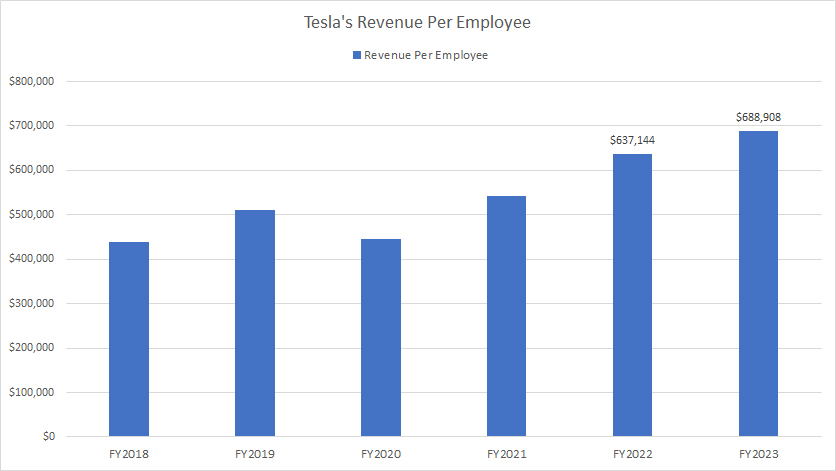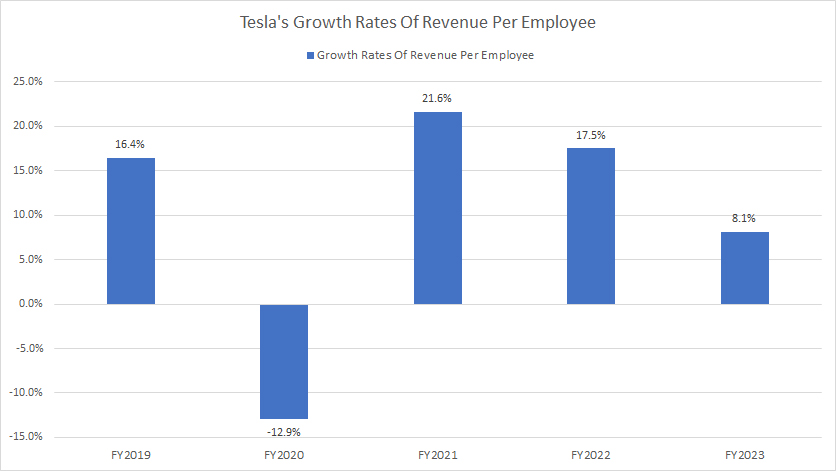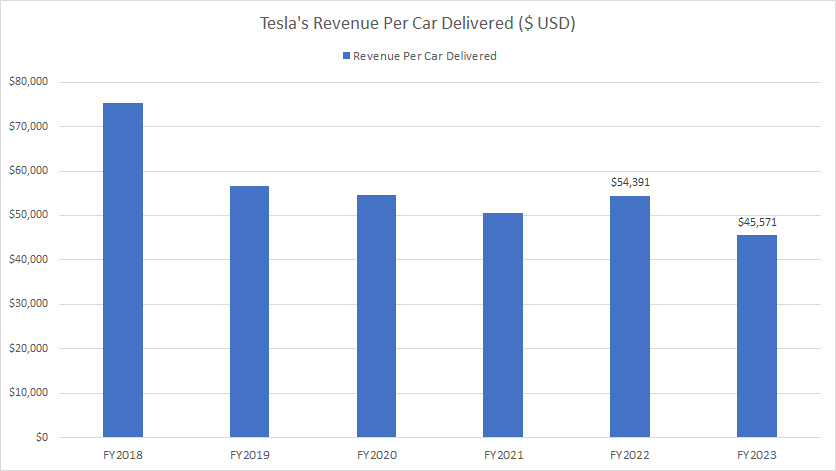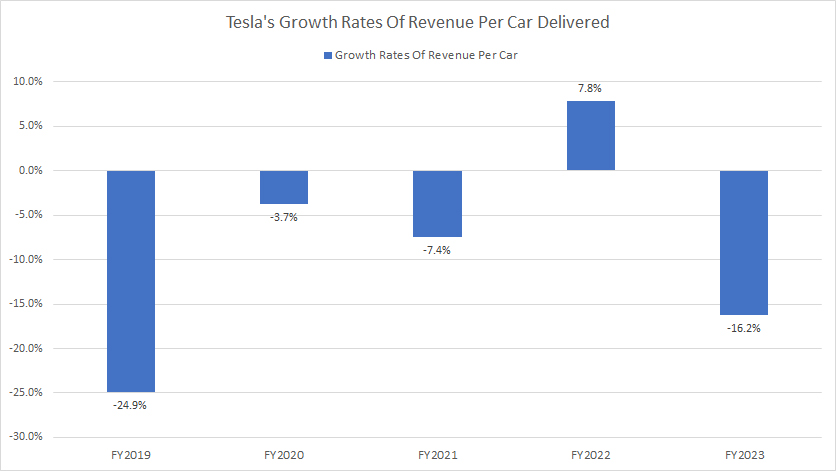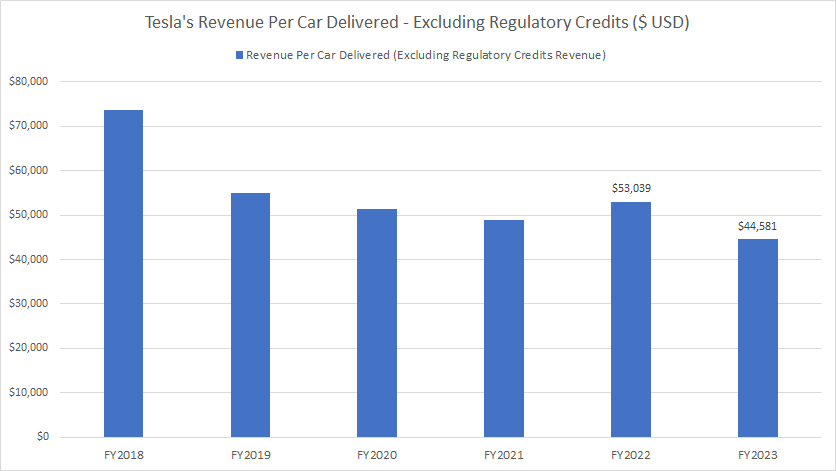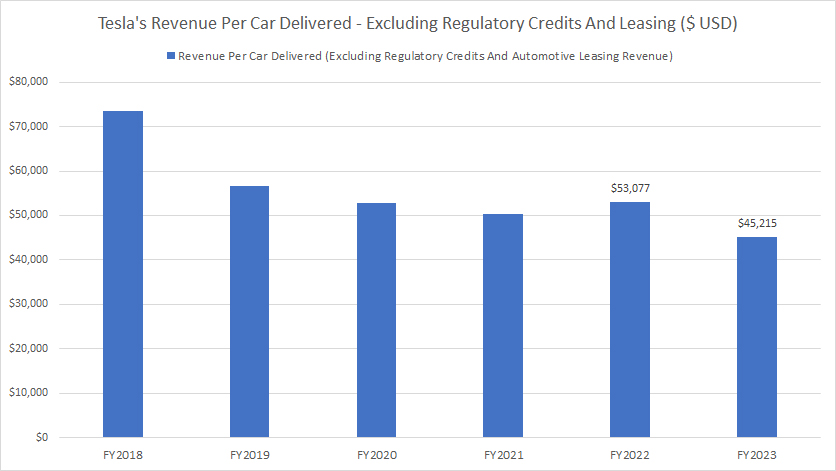
Electric vehicle charging. Pixabay Image
This article covers the revenue per employee and revenue per car of Tesla, Inc., (NASDAQ: TSLA).
Let’s look at the numbers!
Investors interested in Tesla revenue and vehicle sales may find more information in these articles: Tesla production and delivery and Tesla revenue.
Please use the table of contents to navigate this page.
Table Of Contents
Definitions And Overview
O2. How Fast Is Tesla Growing?
Per Employee Results
A1. Revenue Per Employee
A2. Growth Rates Of Revenue Per Employee
Per Vehicle Results
B1. Revenue Per Car (1)
(Include Regulatory Credits And Automotive Leasing)
B2. Growth Rates Of Revenue Per Car (1)
B3. Revenue Per Car (2)
(Exclude Regulatory Credits)
B4. Revenue Per Car (3)
(Exclude Regulatory Credits And Automotive Leasing)
Conclusion And Reference
S1. Conclusion
S2. References and Credits
S3. Disclosure
Definitions
To help readers understand the content better, the following terms and glossaries have been provided.
Revenue Per Employee: Tesla’s revenue per employee is a financial metric that measures the amount of revenue generated by the company per individual employee.
This figure is calculated by dividing the company’s total revenue by its current number of employees. This metric is often used to gauge the efficiency and productivity of a company’s workforce.
Here is the formula:
Revenue Per Employee = Total Revenue / Total Number Of Full-Time Employees Worldwide
Tesla’s total revenue in the above equation refers to the consolidated revenue earned from all segments, including the automotive, energy, and services.
The actual figure can vary annually and depends on Tesla’s performance in a given fiscal year and its workforce size at that time.
Revenue Per Car: Revenue per car for Tesla, or any automotive manufacturer, is a financial metric that calculates the average revenue generated from each vehicle’s sale.
This is determined by dividing the company’s total automotive revenue by the number of cars delivered in a specific period, usually reported quarterly or annually.
Here is the formula:
Revenue Per Car = Automotive Revenue / Total Vehicles Sold Worldwide
Tesla’s automotive revenue in the above equation includes Tesla’s automotive sales revenue, automotive leasing revenue, and sales of regulatory credits.
The automotive revenue in this section includes all revenue and sales earned under the automotive segment which can range from new vehicle sales, vehicles under leases, parts, accessories, Supercharging, Full Self Driving, etc.
Similar to revenue per employee, this figure offers insights into the company’s sales efficiency and vehicle pricing strategy. The actual revenue per car can fluctuate based on factors such as changes in vehicle prices, the mix of models sold, and overall sales volumes.
How Fast Is Tesla Growing?
Tesla, Inc. has been one of the fastest-growing companies in the automotive sector, particularly in the electric vehicle (EV) market. Over the last several years, Tesla’s growth can be characterized by its rapid increase in EV production volume, expansion into new markets, and diversification of its product lineup.
1. **Production Growth**: Tesla has significantly increased its production capacity. From producing about 50,000 vehicles in 2015, Tesla ramped up its production to deliver nearly 1.31 million vehicles in 2021. The company aims to maintain a growth rate in vehicle deliveries of around 50% annually over a multi-year horizon.
2. **Market Expansion**: Tesla is growing not just in terms of production numbers but also geographically. Initially focused on the U.S. market, Tesla has expanded globally, entering European, Chinese, and other Asian markets. The construction of Gigafactories in Shanghai, Berlin, and Texas is a strategic move to cater to local demand and reduce shipping costs.
3. **Product Lineup Diversification**: Tesla started with a high-end sports car, the Roadster, and gradually expanded its lineup to include more accessible models like the Model S, Model X, Model 3, and Model Y. The expansion into different market segments, including the upcoming Cybertruck and the Semi, aims to cater to a broader audience.
4. **Energy Products and Services**: Beyond vehicles, Tesla’s growth is also propelled by its energy products and services, including solar panels, solar roofs, and energy storage solutions like the Powerwall, Powerpack, and Megapack. This diversification positions Tesla not just as an automaker but as an energy company.
5. **Innovation and Autonomy**: Tesla’s commitment to innovation, especially in electric powertrains, battery technology, and autonomous driving capabilities, keeps it at the forefront of the EV market. Advances in battery technology aim to reduce costs and increase vehicle range, making EVs more accessible to the average consumer.
Tesla’s growth is driven by its innovative products, aggressive expansion strategy, and the increasing global shift towards sustainable and electric transportation. However, it’s important to note that Tesla’s journey includes challenges such as production bottlenecks, competition from established automakers and new EV startups, and regulatory hurdles. Despite these challenges, Tesla’s growth trajectory remains a closely watched aspect of the automotive and energy industries.
Revenue Per Employee
Tesla-revenue-per-employee
(click image to expand)
The definition of Tesla’s revenue per employee is available here: Tesla revenue per employee.
At the end of fiscal 2023, Tesla’s revenue per employee is estimated at $689,000, a rise of 8% over 2022.
In other words, each Tesla’s employee generates roughly $689,000 in revenue per year for the company.
This figure has been on a steady rise and has risen by 50% since fiscal 2018.
On a side note, Tesla had roughly 140,000 full-time employees globally at the end of fiscal 2023.
Growth Rates Of Revenue Per Employee
Tesla-growth-rates-of-revenue-per-employee
(click image to expand)
The definition of Tesla’s revenue per employee is available here: Tesla revenue per employee.
Tesla’s revenue per employee grew just 8% in fiscal year 2023, which was significantly smaller than the growth rate of 17.5% measured in fiscal year 2022 and also all positive growth rates in prior years.
In short, the growth of Tesla’s revenue per employee has significantly slowed.
Revenue Per Car (1)
Tesla-revenue-per-car-1
(click image to expand)
The definition of Tesla’s revenue per car is available here: Tesla revenue per car.
That said, Tesla generated roughly $45,600 of revenue per vehicle at the end of fiscal year 2023, down 16% over 2022.
This figure has been on a steady decline over the years and has declined by more than 30% since fiscal 2018.
Although the revenue per car has been on the decline over the long term, it rose abruptly in fiscal 2022, driven possibly by inflation caused by higher prices of raw materials and labor.
Growth Rates Of Revenue Per Car (1)
Tesla-growth-rates-of-revenue-per-car-1
(click image to expand)
The definition of Tesla’s revenue per car is available here: Tesla revenue per car.
The growth of Tesla’s revenue per car has significantly slowed, according to the chart above.
In most fiscal years, Tesla has registered a declined in revenue per car. As of fiscal year 2023, Tesla’s revenue per car declined 16% over a year ago versus a growth rate of 8% in fiscal year 2022.
Revenue Per Car (2)
Tesla-revenue-per-car-2
(click image to expand)
The formula for revenue per vehicle in this section is:
Revenue Per Car = Automotive Revenue (Excluding Regulatory Credit Revenue) / Total Vehicles Sold Worldwide
The automotive revenue measured in this section excludes the sales of regulatory credits (carbon credits) as the revenue earned from regulatory credits may be considered as a by-product of the vehicle sales, as claimed by some parties.
That said, Tesla’s revenue per car measured in this section is slightly lower compared to the previous section but not much.
As seen, Tesla earned a revenue per car of $44,600 in fiscal 2023 after excluding regulatory credits, representing a decline of 16% over 2022.
Similarly, Tesla’s revenue per car has been on the decline over the long term with or without regulatory credits revenue.
Therefore, Tesla’s regulatory credits revenue only helps the company earn a slightly higher revenue per vehicle delivered.
Revenue Per Car (3)
Tesla-revenue-per-car-3
(click image to expand)
The formula for revenue per vehicle in this section is:
Revenue Per Car = Automotive Revenue (Excluding Regulatory Credit And Automotive Leasing Revenue) / Vehicles Sold Worldwide Not Subject To Leasing
The automotive revenue measured in this section excludes the sales of regulatory credits (carbon credits) and automotive leasing.
In addition to the revenue part, the number of vehicles sold also is refined to only those not subject to leasing.
Despite having all the adjustments, Tesla’s revenue per car still came in at $45,200 in fiscal 2023, not much different from the previous calculation.
This figure also has been on a steady decline over the years but grew abruptly in fiscal 2022 by 6% year-over-year, possibly driven by inflation.
In short, the trend of Tesla’s revenue per car looks all the same even with some adjustments to the formula.
Summary
In conclusion, Tesla’s employees help the company make a hefty load of money, notably at nearly $700,000 per year per employee.
Tesla’s revenue per car has come down quite significantly over the past 5 years and the downtrend will most likely continue in the foreseeable future.
References and Credits
1. All financial figures presented in this article were obtained and referenced from the company’s SEC filings, earnings releases, investors presentations, update letters, quarterly and annual reports, etc., which are available in Tesla Financial Results.
2. Featured images in this article are obtained free and are used without any attribution from Pixabay.
Disclosure
References and examples such as tables, charts, and diagrams are constantly reviewed to avoid errors, but we cannot warrant the full correctness of all content.
The content in this article is for informational purposes only and is neither a recommendation nor a piece of financial advice to purchase a stock.
If you find the information in this article helpful, please consider sharing it on social media and also provide a link back to this article from any website so that more articles like this one can be created in the future.
Thank you!


